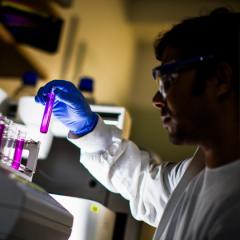
A native Australian grass is at the centre of research aiming to develop renewable materials for air and water filters, battery separators, metal replacements and wound dressings.
Researchers at the Australian Institute for Bioengineering and Nanotechnology, at The University of Queensland, are part of a collaboration to turn Spinifex into a material called nanofibrillated cellulose.
The research will involve teams led by AIBN’s Prof Darren Martin; Prof Paul Memmott from UQ’s School of Architecture; and Prof Susanne Schmidtfrom the School of Agriculture and Food Sciences.
They will work in collaboration with indigenous industry partner the Myuma Group, owned and managed by the Indjalandji-Dhidhanu traditional ownes of the Camooweal area.
Almost $75,000 in funding from a UQ Collaboration and Industry Engagement Fund (CIEF) Seed Research Grant will enable AIBN to develop a process to make and scale up the material.
The funding will also enable Prof Schmidt’s team to determine the best species of Spinifex for use.
A joint appointment at the School of Architecture and Institute for Social Science Research, Prof Memmott will lead a team working with Aboriginal communities to source the grass and investigate harvesting methods.
Prof Martin said the research was at the core of an initiative which could grow to include industry partners and Aboriginal communities.
“We are excited at the results we have so far and confident we can develop a truly scalable process to convert Spinifex as a renewable feedstock for a superior nanofibrillated cellulose,” Prof Martin said.
“We can then think about building on the research to develop a multitude of applications for the material and investigate the infrastructure needed to source the Spinifex in an efficient, sustainable and responsible manner.”
The 70 species of Spinifex are unique to Australia, covering about a third of the continent’s landmass and growing in some of the hottest and driest places in the world.
Spinifex is unique in not needing harsh chemical treatments and high energy mechanical processing to convert into nanofibrillated cellulose.
The nanofibrils have a high surface area and exceptional mechanical properties. A single nanofibril is stiffer than Kevlar and has a tensile strength eight times that of steel.
This makes the nanofibrillated cellulose suitable for filtration, requiring small pores to capture pollutants and strength to withstand air and water pressure.
Other uses include membranes for batteries and capacitors in hybrid or electric cars and wound dressings capable of preventing infection.
Materials used for those purposes at the moment are made from wood pulping by-product, sourced from overseas, primarily from Canada, Sweden and Finland.
The wood pulping by-product is cheap but the process in converting it is more expensive – because of the chemicals and mechanical energy required.
AIBN student Nasim Amiralian began the Spinifex conversion process as part of her PhD studies, creating ropey nanofibres which were thinner and longer than generally achieved in the industry.
However, work needs to be done to investigate the costs and processes for harvesting the Spinifex to ensure it is a viable alternative.
The researchers plan to use a species of Spinifex which grows naturally around Camooweal, west of Mt Isa.
They collaborate with Camooweal’s Myuma Group, that operates an award-winning enterprise and training practice on behalf of the region’s indigenous communities and aims to create an Aboriginal-owned Spinifex bio-refining industry.
CIEF is an internal UQ grant scheme to support the development of highly competitive proposals, to encourage new industry-linked research, provide seed-funding to generating high-quality applications to Federal Government funding bodies and support cross-disciplinary initiatives.


